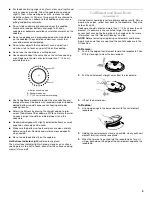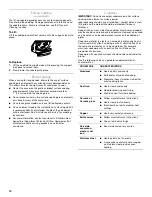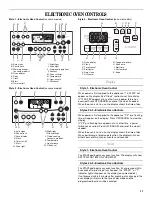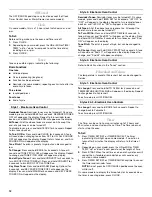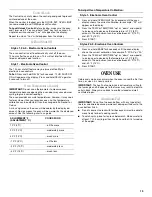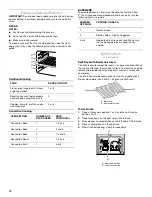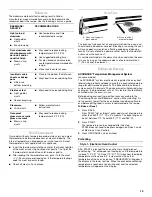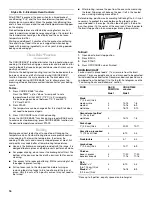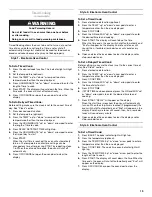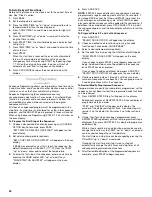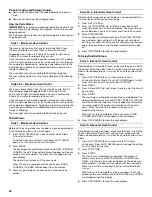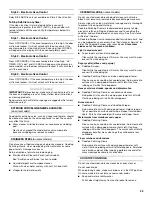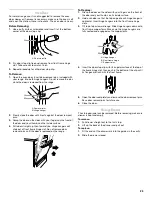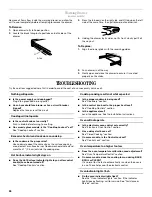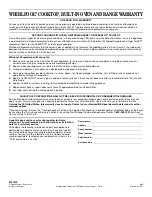
23
Style 3 - Electronic Oven Control
Delay Start Self-Clean is not available on Style 3 Oven Control.
To Stop Self-Clean any time:
If the clean function is terminated while the oven cavity
temperature is greater than 500ºF (260ºC), the oven door will
remain latched until the oven cavity temperature is below this
threshold.
Style 1 - Electronic Oven Control
Press OFF/CANCEL. If the oven temperature is too high, the door
will remain locked. It will not unlock until the oven cools. If the
oven temperature is too high after self-cleaning, then LOCKED
will appear on the display until the oven completely cools.
Style 2 - Electronic Oven Control
Press OFF/CANCEL. If the oven temperature is too high, “cln,”
TIMED, ON, “cool,” and LOCKED will appear on the display (on
some models), and the door will remain locked. It will not unlock
until the oven cools.
Style 3 - Electronic Oven Control
Press OFF/CANCEL. If the oven temperature is too high, the door
will remain locked. It will not unlock until the oven cools.
General Cleaning
IMPORTANT: Before cleaning, make sure all controls are off and
the oven and cooktop are cool. Always follow label instructions
on cleaning products.
Soap, water and a soft cloth or sponge are suggested first unless
otherwise noted.
EXTERIOR PORCELAIN ENAMEL SURFACES
(on some models)
Food spills containing acids, such as vinegar and tomato, should
be cleaned as soon as the entire appliance is cool. These spills
may affect the finish.
■
Glass cleaner, mild liquid cleaner or nonabrasive scrubbing
pad:
Gently clean around the model and serial number plate
because scrubbing may remove numbers.
STAINLESS STEEL (on some models)
Do not use soap-filled scouring pads, abrasive cleaners, Cooktop
Polishing Creme, steel- wool pads, gritty washcloths or some
paper towels. Damage may occur.
Rub in direction of grain to avoid damaging.
■
Stainless Steel Cleaner & Polish (not included):
See “Assistance or Service” section to order.
■
Liquid detergent or all-purpose cleaner:
Rinse with clean water and dry with soft, lint-free cloth.
■
Vinegar for hard water spots
CERAMIC GLASS (on some models)
Do not use steel wool, abrasive powder cleansers, chlorine
bleach, rust remover or ammonia because damage may occur.
Always wipe with a clean, wet cloth or sponge and dry thoroughly
to prevent streaking and staining.
Cooktop Polishing Creme is recommended regularly to help
prevent scratches, pitting and abrasions and to condition the
cooktop, and can be ordered as an accessory. See “Assistance
or Service” to order.
A Cooktop Scraper is also recommended for stubborn soils, and
can be ordered as an accessory. See “Assistance or Service” to
order. The Cooktop Scraper uses razor blades. Store razor
blades out of the reach of children.
Light to moderate soil
■
Paper towels or clean damp sponge:
Clean while the cooktop is still warm. You may want to wear
oven mitts while doing so.
Sugary spills (jellies, candy, syrup)
■
Cooktop Scraper:
Clean while the cooktop is still warm. You may want to wear
oven mitts while doing so.
■
Cooktop Polishing Creme and clean damp paper towel:
Clean as soon as cooktop has cooled down. Rub creme into
surface with a damp paper towel or soft cloth. Continue
rubbing until white film disappears.
Heavy soil, dark streaks, specks and discoloration
■
Cooktop Polishing Creme or nonabrasive cleanser:
Rub product into soil with a damp paper towel or soft cloth.
Continue rubbing until white film disappears.
Burned-on soil
■
Cooktop Polishing Creme and Cooktop Scraper:
Rub creme into soil with damp paper towel. Hold scraper as
flat as possible on surface and scrape. Repeat for stubborn
spots. Polish entire cooktop with creme and paper towel.
Metal marks from aluminum and copper
■
Cooktop Polishing Creme:
Clean as soon as cooktop has cooled down. Rub creme into
surface with a damp paper towel or soft cloth. Continue
rubbing until white film disappears. The marks will not totally
disappear but after many cleanings they will become less
noticeable.
Tiny scratches and abrasions
■
Cooktop Polishing Creme:
Rub creme into surface with a damp paper towel or soft
cloth. Continue rubbing until white film disappears. Scratches
and abrasions do not affect cooking performance and after
many cleanings become less noticeable.
COOKTOP CONTROLS
Do not use steel wool, abrasive cleansers or oven cleaner.
Do not soak knobs.
When replacing knobs, make sure knobs are in the OFF position.
On some models, do not remove seals under knobs.
■
Soap and water or dishwasher:
Pull knobs straight away from control panel to remove.

